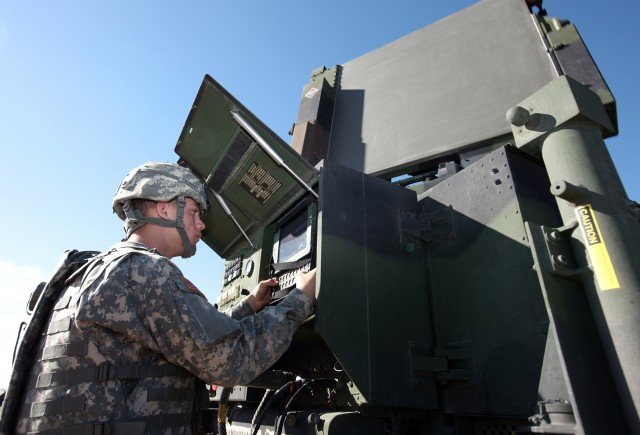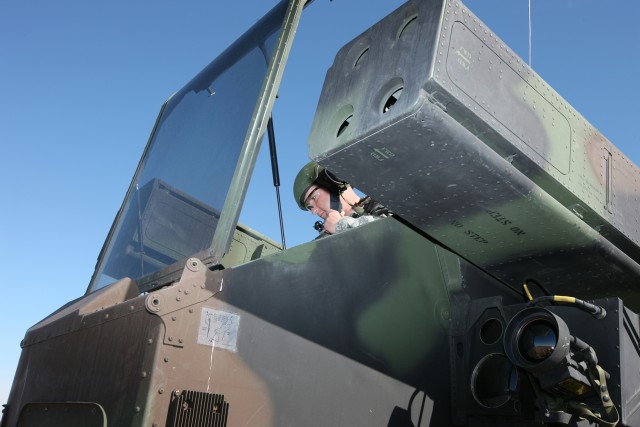In a command and control tent, Pvt. Justin Dunning scrutinized his radar monitor, looking for any enemy aircraft that had been detected by an Air Force E-3 Airborne Warning and Control Systems aircraft flying hundreds of miles away.
Once a hostile aircraft's track was fed to him by AWACS controllers, he alerted his Engagement Control Station. ECS operators directed a nearby Avenger air defense weapon to fire at the aircraft. The ECS crew tracked the Avenger's Stinger missile as it honed in on its target ...
Dunning, an early warning system operator, was one of several hundred Soldiers and airmen who participated in the 31st Air Defense Artillery Brigade's Joint Kill Chain Exercise Feb. 24 through 26 at the Fort Sill training areas.
The exercise was designed to test the brigade's ability to coordinate the tracking and engagement of enemy targets with the participation of other military services. It was the first ADA exercise here and involved the brigade's 6th Battalion, 52nd ADA (Patriot); 5-5 ADA (Avenger) from Fort Lewis, Wash.; headquarters Tactical Operations Center; and Air Force units from Altus, Sheppard and Tinker Air Force bases.
Four ADA batteries of long-range and short-range radars camped throughout the training ranges during the three-day exercise. The exercise did not involve live air defense artillery fire, instead electronic simulations "fired" Patriot and Stinger missiles and tracked their progress.
"The ability to interact with the AWACS on a daily basis and do these engagements is a very unique opportunity and it's something that we've never been able to do before," said Lt. Col. Robert Kelley, battalion commander, 6-52 ADA. "That's been a significant benefit."
And, the exercise was a great way to operationalize the installation commander's vision of making Fort Sill a joint fires center, said Col. Daniel Karbler, brigade commander, 31st ADA. The next step will be to add field artillery to the exercise, he said.
Part of the Joint Kill Chain involved ADA batteries to fire and track Patriot and Stinger missiles engaging aircraft and missiles.
The Sentinel radar provided 360 degree coverage of short-range air defense to supplement the Patriot air defense system's long-range coverage of 180 degrees, said Sgt. Christopher Columbus, of the 5-5 ADA, who manned a Sentinel site.
"If any tracks are behind them we can pick that up," said Columbus, an air defense command and control system maintainer and operator. "They don't have launchers out here today. In place of launchers, we are using Avengers, which are basically humvees with Stinger missiles on the back of it." The Avenger is also equipped with a .50 caliber machine gun.
The Patriot and Sentinel systems both tracked the same threats, said Staff Sgt. John Forbis, squad leader of B, 5-5 ADA.
We'll make the call on which team has the better shot," Forbis said. "The team that doesn't fire will be the overlapping support if it is missed or doesn't fully take out the threat."
A Small Manned Aerial Radar Target Model 1, or SMART-1, simulated a cruise missile and flew at about 1,000 feet and 300 mph over the training areas, said pilot John Lamb, of the Freedom Team from Tucson, Ariz.
The SMART jet was detected on the radars long before any visual contact could be made. The batteries performed well against all the air threats, which included F-16 jets, said Columbus, whose battery was on the East Range.
"Every exercise that we engaged in we successfully destroyed every target, either between us or the other three sites," he said.
Battery Commander Capt. Marcel Hickman, of B, 6-52 ADA, said the Joint Kill Chain Exercise was realistic and a unique opportunity for him and the Soldiers of his Patriot air defense system to get familiar working with Soldiers from the Sentinel radar and Avenger system.
"Working together we realize we both need each other to be successful," he said.
Hickman said that the exercise went very well.
"The operators have had the opportunity to see a live track on their scope ... and actually going through the process of who's going to engage that track whether that's us or the short range air defense unit."
At the end of each day, the battery crews and pilots shared lessons learned, Karbler said.
"We cross talk the lessons between the different crews. Everyday it's gotten a little better," he said. "It's very beneficial." At the end of the exercise, an overall after action report was provided to the installation commander.
This was the last exercise for the 6-52 ADA at Fort Sill. In May, the unit will permanently move to South Korea, where they will become part of a joint air defense system, Kelley said.
"The (Joint Kill Chain) exercise is a tremendous opportunity for us to rehearse and practice joint procedures with our brethren," he said.






Social Sharing